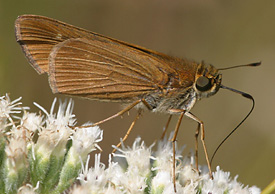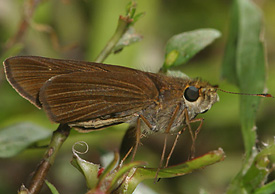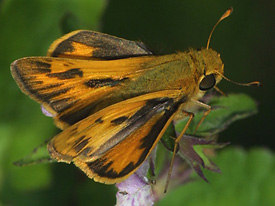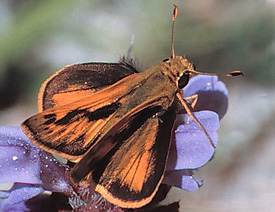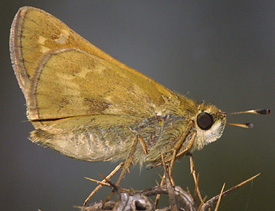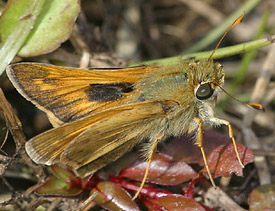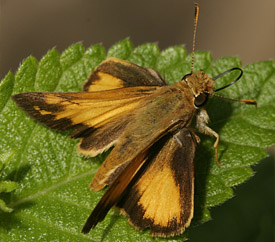Skippers, yes skippers most beginners
think skippers are hard to learn. What you want to do is learn one or
two at a time. Before long, you'll know it you'll know them. Give them
a chance and you will be hooked before you know it. Some worn individuals
might not be identifiable. That's ok; it happens to everyone!
This is one of the easiest common large skippers to learn. Note the large white "silver" patch; it's that simple. They can be found in huge numbers especially in the mountains. The only similar species is the uncommon Hoary Edge which has a white smudge instead of a bright white patch.
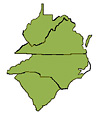 |
Wingspan: 1 3/4 - 2 5/8 inches Flight: Early March until late October |
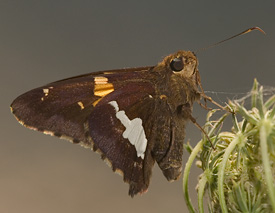
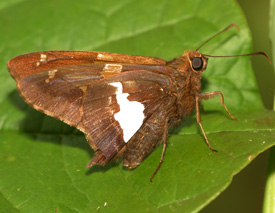
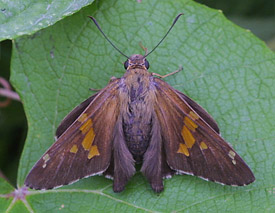
This species is very common and has two other close relatives to add to the confusion. They are the Northern Cloudywing (next species) and the very rare Confused Cloudywing. Note the bold markings; usually this is a helpful key. You should also look for a whitish patch on the bend of the antennal club and whitish face to make sure. In the spring both Northern Cloudywing and Southern Cloudywing are poorly marked and the antennal club whitish patch is needed for identification.
 |
Wingspan: 1 5/16 - 1 7/8 inches Flight: Early April until early October |
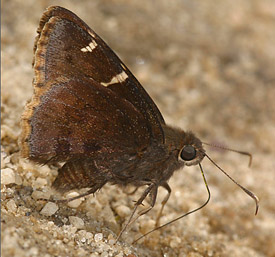
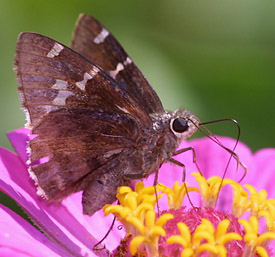
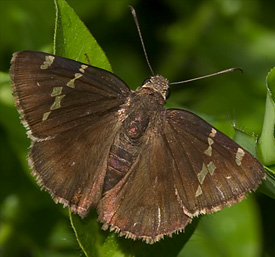
Very common in the region. As noted above, there are two relatives to confuse it with. Look for three triangle-shaped marks on the center of the forewing. The marking are very reduced, if not nearly absent, in spring. The face is brown unlike the Southern Cloudywing's face. Cloudywings can make the day interesting figuring out which one is which. They tend to be found along roadsides and woodland clearings, in wet mud and they will visit gardens.
 |
Wingspan: 1 1/4 - 1 7/8 inches Flight: Late March until late August |

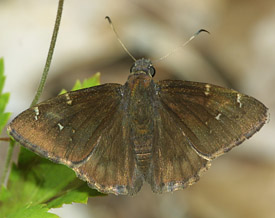
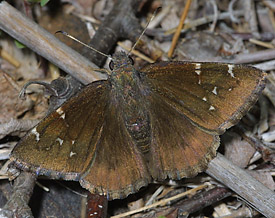
Duskywings during spring can be seen by the hundreds in puddle parties. They can be confusing. Juvenal's has only one spring brood and is by far the most common of the duskywings. Look for the three spots in the center of the forewing. Horace's Duskywing (next species below) is nearly identical and does fly in spring in small numbers most butterfliers cannot tell them apart; you might want to just call them duskywing species if your not sure.
 |
Wingspan:
1 1/4 - 1 3/4 inches Flight: Early March until late May |
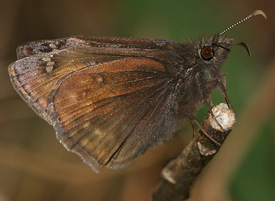
Note the spot near the apex of the hindwing
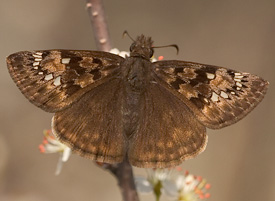
Female is boldly marked
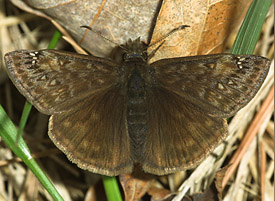
Male
As mentioned above, Horace's does fly in spring and can be very hard to tell from Juvenal's. When the first duskywings are worn and on the way out, the fresh large duskywings from then on into fall can only be Horace's Duskywing. There are two other all season duskywings that are much harder to find. They include Wild Indigo Duskywing and Zarucco Duskywing.
 |
Wingspan: 1 1/4 - 1 3/4 inches Flight: Early April until early October |

Note the hindwing has no spot near apex
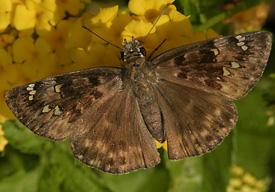
Female is boldly marked
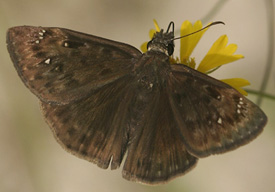
Male
These fast fliers like large open lawns and will visit gardens. Identification is fairly easy as the similar Tropical Checkered-Skipper is a stray into the southern portion of the region. In recent years the White Checkered-Skipper has replaced this species in northern FL and southern GA. Telling these two apart without dissection is impossible so some people just record seeing Common/White Checkered-Skipper and leave it as that.
 |
Wingspan: 1 - 1 1/2 inches Flight: Early April until early October |
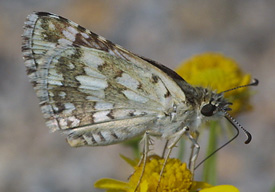
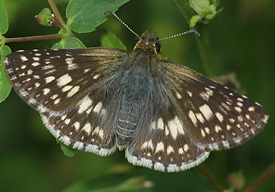
Female has more brown
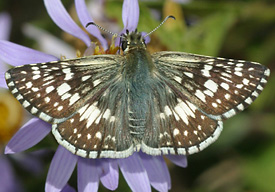
Male shows more white
These are tiny skippers and are often overlooked. They tend to like wet muddy places, gardens and farms. Lambsquarters is the host plant and it is a weed found in disturbed soils like farm fields and even construction sites. Look for the four white spots on top of the head, no other skipper has these spots.
 |
Wingspan: 7/8 - 1 1/4 inches Flight: Early April until late September |
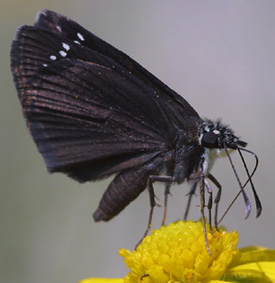
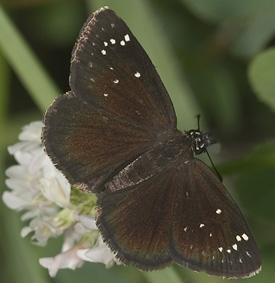
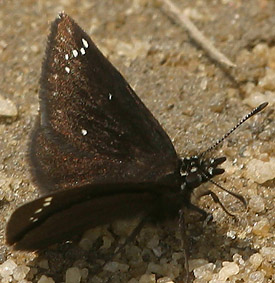
This is an early morning skipper and usually the first one you might see on a damp morning. The skipper shown below left is very fresh; the purple sheen wears away quickly and most you find will be browner and very plain. Note the marking from above, these are helpful.
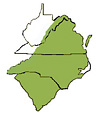 |
Wingspan: 1 1/4 - 1 3/4 inches Flight: Early April until early November |
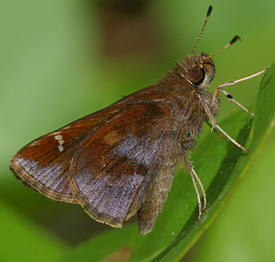
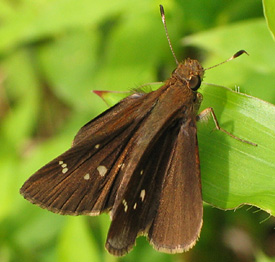
Female has several white spots
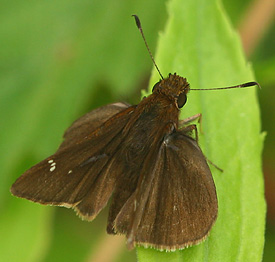
Male barely has spots
This is a tiny skipper. Its weak slow flight is a give away even before it lands. Usually finding this skipper is easy, just walk though wet grassy areas such as creek or pond edges. In the coastal plain Southern Skipperling is similar, but does not fly like the Least Skipper. During early summer in the WV mountains the European Skipper might also confuse you. This is a very easy skipper to learn.
 |
Wingspan: 7/8 - 1 1/8 inches Flight: Mid April until late October |
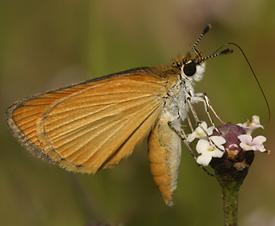
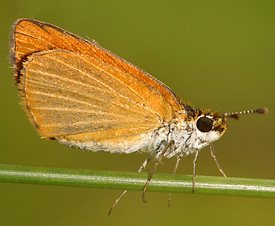
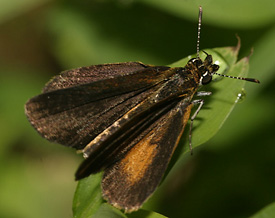
Very common to abundant garden skipper especially in the southern portion of the region. Learn this one as you're sure to see it in about any garden during the entire summer. In the southern coastal plain the Whirlabout (next species below) is similar with much larger dark spots.
 |
Wingspan: 1 1/4 - 1 1/2 inches Flight: Mid April until late November |
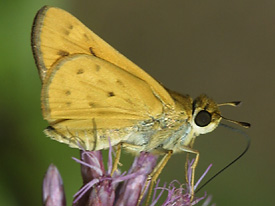
Male has many small dark spots
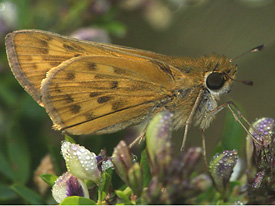
Female is longer and marked stronger
Must be named because of the fast whirly flight. These can be common in the southern coastal plain. They visit gardens and can be found in about any open sunny situations. Many mistakenly call the Fiery Skipper a Whirlabout as the males look very much alike from above.
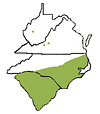 |
Wingspan: 1 - 1 1/2 inches Flight: Mid April until early November |
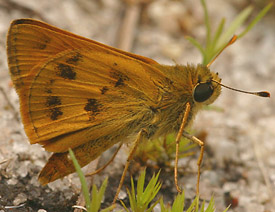
Male, note the brown blotches
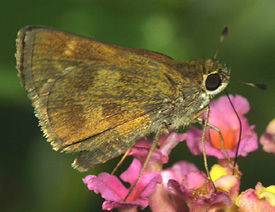
Female
Although the range map shows Crossline Skipper in the entire region, it's not common in the Virginias like it is in the Carolinas. It is brown with spots that form a Vee and when worn very difficult to identify as these spots fade away. Worn individuals might not be identifiable. The darker Little Glassywing (next species below)is similar although the spots on the underside do not form a Vee.
 |
Wingspan: 1 1/8 - 1 1/2 inches Flight: Mid May until late October |

Note the spots on hindwing in slight Vee
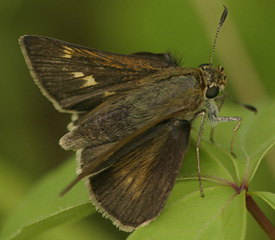
Female
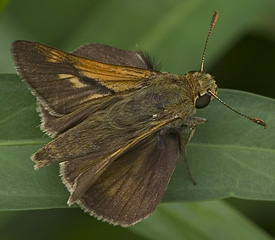
Male
This small dark brown skipper is found mostly near wet areas and can be difficult to identify. The large square light spot, as shown below far right, is the easier mark to look for. Also look at the antennas; they are pale before the antenna tips. Another confusing species is the Northern Broken-Dash.
 |
Wingspan: 1 1/16 - 1 1/2 inches Flight: Late April until mid October |
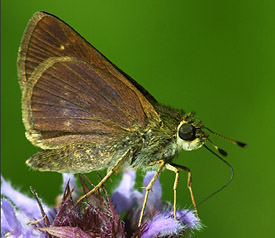
When fresh they have a violet sheen
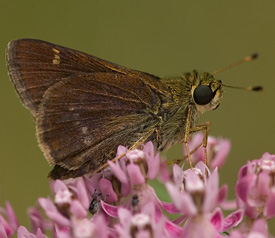
Note, antenna is always pale before the tips

The large square light spot is a key mark
This is likely the most common skipper in gardens in the region. This is a must learn skipper as it will ease your confusion in learning skippers. Note the large dark spot on the male photo at below far right. No other skippers have this large spot. You might mistake the female for a female Fiery Skipper.
 |
Wingspan: 1 1/4 - 1 5/8 inches Flight: Early April until mid November |
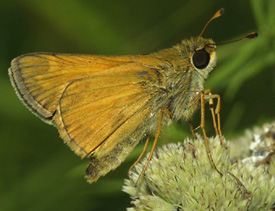
Male the ground orange coloring
As you can see the males and females are very different from each other. Zabulon Skipper is very territorial and can be found in sunny spots along woodland edges, trails, roadsides and will visit gardens if near woodland edges. They seem to be in the business of chasing each other more than any other skipper I know of. During spring in the mountains the slightly larger Hobomok Skipper is similar.
 |
Wingspan: 1 3/8 - 1 5/8 inches Flight: Late April until late September |
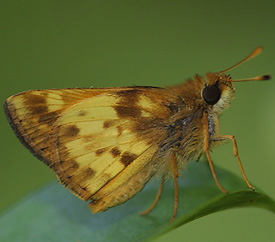
Male, bright yellow hindwing is dark at body
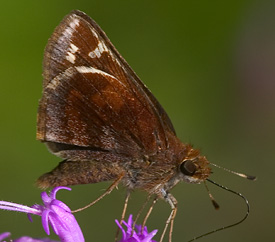
Female, note whitish top of hindwing
This plain brown skipper has very little if any small white spots on the upperside. Usually it has a slightly golden head making getting the identification somewhat easy. They tend to be found in somewhat damp locations and can be regular garden visitors. I've noted that after an afternoon shower they are likely to be the first returning visitor to the garden after the rain.
 |
Wingspan: 1 1/8 - 1 3/8 inches Flight: Late April until late October |
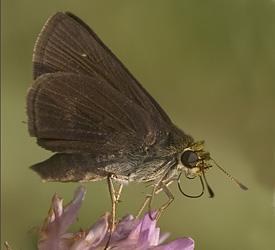
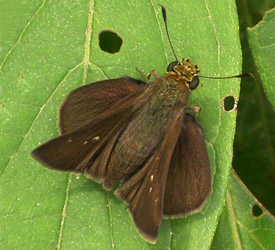
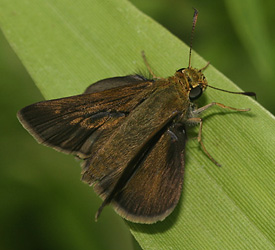
This skipper is found over most of the southern US. The extremely long forewings make it very easy to identify. Most years, fair numbers of Ocola Skippers show up in late summer s they migrate northward. Notice the chevron-shaped cream spot on the upperside.
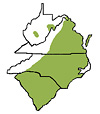 |
Wingspan: 1 1/4 - 1 3/8 inches Flight: Early June until late November |
